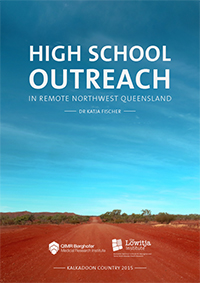Science and young minds
Youth engagement in skin health
The QIMR Berghofer’s Science and young minds project aimed to inspire the scientists and medical professionals of tomorrow. The research team relayed the importance of medical research and health related professions to senior high school students in remote areas of north-west Queensland, targeting engagement of students with Aboriginal and Torres Strait Islander backgrounds. The project included the development and delivery of science workshops to high schools in remote north-west Queensland in 2014 and 2015 with selected student and teacher participation in a laboratory work experience program at the QIMR Berghofer Medical Research Institute in Brisbane.
Project objectives
- Engage young people in discussions, learning and hands on activities about skin health and medical research, relevant to local needs.
- Promote discussion and reflection about science and its role in helping to solve health problems, and to promote health science and research as viable career pathways for senior high school graduates.
- Share knowledge of parasitology and infectious diseases, and increase awareness of health related issues, such as scabies and associated bacterial diseases, which are a major issue in remote northwest Queensland.
Benefits and outcomes
- Successful development and delivery of a two-day science workshops to year 10–12 students at remote high schools in north-west Queensland – Cloncurry State School in 2014 and Mt Isa Flexible Learning Centre, and Cloncurry State School in 2015. The classrooms were transformed into a ‘real-life’ research laboratory with students undertaking ‘hands on’ experiments in practical sessions in molecular parasitology and microbiology. The practical sessions were complemented by a series of introductory presentations, a ‘Parasite Quiz’, and a ‘Career in Health and Medical Research’ workshop.
- Two cohorts of selected students and accompanying teachers travelled to Brisbane and completed a work experience program at QIMR Berghofer in 2014 and 2015. The students were introduced to laboratory work in a one-day course and then carried out ‘hands on’ experiments over several days in the hosting scabies laboratory at QIMR Berghofer. They also visited other laboratories and facilities within the institute, and attended the QIMR Berghofer high school lecture day.
- Students participated in excursions, including:
- Herston Campus and the Royal Brisbane and Children Hospitals, including a visit to Queensland University’s Integrated Pathology Learning Centre where students developed an understanding of the effects of behavioural and environmental factors on health (with a focus on cancer, alcohol consumption and smoking), the role of research in understanding disease, and the ethical issues associated with the use of human tissue specimens in science and education
- Queensland University of Technology (QUT), including: the Oodgeroo Unit, where QUT students discussed ways of embracing university life; a tutorial and tour at the QUT Kelvin Grove library; and a ‘Cube’ tour and a ‘collaborative learning’ workshop at the QUT Gardens Point Campus.
- Increased student and community awareness of local skin related health issues, and the role of medical research and health professions in solving these health problems.
- Promotion of science and research as possible career pathways for young Aboriginal and Torres Strait Islander people currently living in remote locations.
- Increased connection between researchers and remote communities.
Related resources:
- Scabies mite complement inhibitors as targets for novel therapeutics project
- K. Fischer 2016, High School Outreach in Remote Northwest Queensland, The Lowitja Institute, Melbourne


